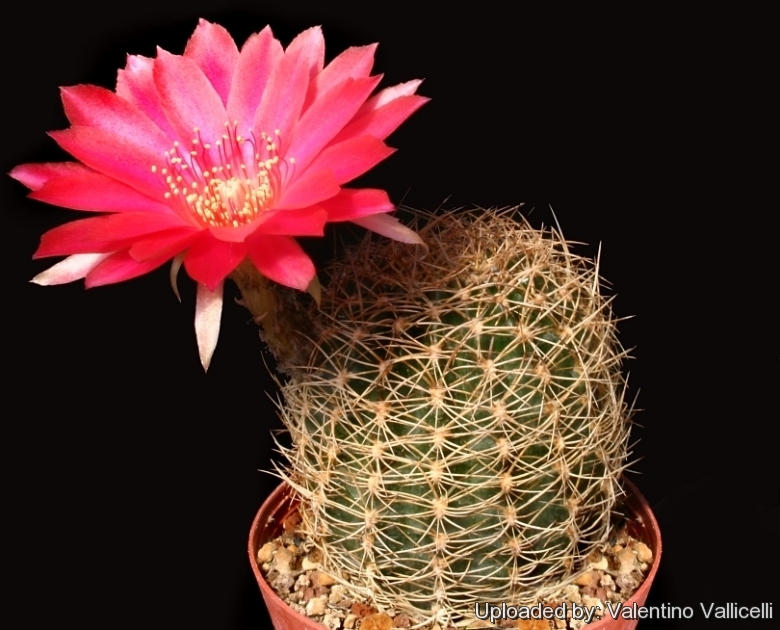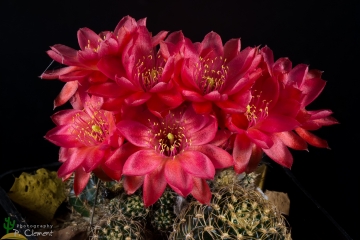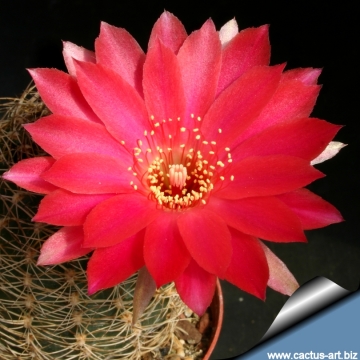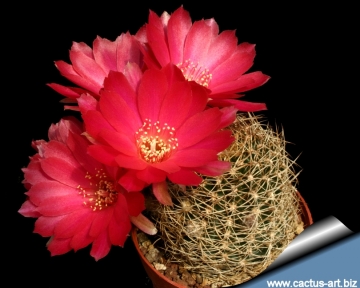Accepted Scientific Name: Echinopsis schieliana (Backeb.) D.R.Hunt
Bradleya 5: 92 (1987)

Lobivia backebergii subs. schieliana (Echinopsis schieliana) Photo by: Valentino Vallicelli
This species has spidery spines and beautiful spectacular red flowers.
Origin and Habitat: The species was found in the valley of Río Consata, La Paz, Bolivia and spreads in the adjacent Tarija.
Altitude: It can be found at altitudes between 2400 and 3200 meters above sea level.
Habitat: Echinopsis schielianaSN|13469]]SN|15861]] is locally common among grasses and large boulders on flats, slopes and ridges, often together with Echinopsis maximilianaSN|15861]]SN|13469]].
Synonyms:
See all synonyms of Echinopsis schieliana
back
Accepted name in llifle Database:Echinopsis schieliana (Backeb.) D.R.HuntBradleya 5: 92 (1987)Synonymy: 16
back
Common Names include:
RUSSIAN (Русский): Эxинопсис Шиля
Description: Echinopsis schielianaSN|15861]]SN|15861]] (best known as Lobivia schielianaSN|15862]]SN|15862]]) is a cute prolific clumper cactus with dark reddish-green stems underneath white or brownish spidery-spines, flowers are mostly a brilliant light-red and slender.
Habit: Plants generally forming clusters from basal branching.
Stems: Globose to cylindrical, often slender, to 4,5 cm long or more and 4-6 cm in diameter, dark reddish-green or blackish.
Ribs: 13-21 straight or somewhat spiralling 3-5 mm hight.
Areoles: 3-6 mm apart.
Spines: Creamy-white, yellowish or brownish, in age fading to grey.
Central spine: 1-4, often absent at first, similar to the radials but often darker, light brown to brown bent downward, 5-6 mm long.
Radial spines: 8-12(-14), pectinate to radiating, interlacing, light brown 2-15 mm long.
Flowers: orange-red to violet (or yellow) 3,5-4 cm in diameter floral bright; pericarpel 3-6 mm long and 3-6 mm in diameter, floral tubes slender 16-18 mm long, filaments violed red. Inner perianth segments violet-red with yellowish-orange or brownish-orange mid-stripe.
Fruit: Subglobose about 1 cm in diameter, dull-green to blackish, pulp white and juicy.
Seeds: 1,5 x 1 mm broad.
Subspecies, varieties, forms and cultivars of plants belonging to the Echinopsis schieliana group
Bibliography: Major references and further lectures
1) Edward Anderson “The Cactus family” Timber Press, Incorporated, 2001
2) James Cullen, Sabina G. Knees, H. Suzanne Cubey "The European Garden Flora Flowering Plants: A Manual for the Identification of Plants Cultivated in Europe, Both Out-of-Doors and Under Glass" Cambridge University Press, 11/Aug/2011
3) David R Hunt; Nigel P Taylor; Graham Charles; International Cactaceae Systematics Group. "The New Cactus Lexicon" dh books, 2006
4) Lowry, M. 2013. Echinopsis schieliana. In: IUCN 2013. "IUCN Red List of Threatened Species." Version 2013.1. <www.iucnredlist.org>. Downloaded on 31 October 2013.
5) Friedrich Ritter "Kakteen in Südamerika: Ergebnisse meiner 20jährigen" Volume 2, Argentinien/Bolivien, Volume 2 Selbstverlag, 1980
6) Curt Backeberg “Die Cactaceae: Handbuch der Kakteenkunde,” Volume 2 G. Fischer, 1959
7) Curt Backeberg: “Descriptiones Cactearum Novarum.” 1957
8) Walter Rausch “Lobivia: The Day Flowering Echinopsidinae from a Geographical Distribution Point of View” Volumes 1-3 R. Herzig, 1975
9) Urs Eggli, Leonard E. Newton “Etymological Dictionary of Succulent Plant Names.” Springer, Berlin/Heidelberg 2010.
 Lobivia backebergii subs. schieliana (Echinopsis schieliana) Photo by: Peiffer Clement
Lobivia backebergii subs. schieliana (Echinopsis schieliana) Photo by: Peiffer Clement Lobivia backebergii subs. schieliana (Echinopsis schieliana) Photo by: Cactus Art
Lobivia backebergii subs. schieliana (Echinopsis schieliana) Photo by: Cactus Art Lobivia backebergii subs. schieliana (Echinopsis schieliana) Photo by: Cactus Art
Lobivia backebergii subs. schieliana (Echinopsis schieliana) Photo by: Cactus Art R207 (Collector: Walter Rausch) Locality: La Paz, Bolivia. Fuzzy white spines hide the stem. (Echinopsis schieliana) Photo by: Valentino Vallicelli
R207 (Collector: Walter Rausch) Locality: La Paz, Bolivia. Fuzzy white spines hide the stem. (Echinopsis schieliana) Photo by: Valentino VallicelliCultivation and Propagation: It is a good beginner cactus and easy to grow and flower. It is quite resistant and occasionally gets covered by bright showy blossoms also neglected in a dry windowsill. Requires good drainage and very porous potting mix. Watering Needs Need regular water in spring to fall but do not water again until dry. Also, it is a species that is dormant in the winter and require very little water (maybe even none) during the cold months. Frost Tolerance: Light frost protection required. Minimum of 5ºC for safe growing (but hardy up to -5°C or less). Requires to be kept below 7°C in winter to flower well in the spring. Sun Exposure: Requires bright light (protect from strong midday sun). In shade the body colour will remain mostly green, while full sun will darken it and give it red/brown body colour. Can be sunburned if moved from shade/greenhouse into full sun too quickly. The amount of sunlight it can withstand without scorching depends upon the how hot it becomes in the summer in the locale in which it is planted. It will have more colour if it receives more light. During the spring it may be able to take full sun until the heat arrives at the end of spring. In an area that has hot afternoon sun, it may be able to take full morning sun, but requires afternoon shade or afternoon light shade.
Propagation: Seeds or offsets that appear at the base; leave them attached to form a cluster, or wait until they are 1/3 the size of the parent and then detach and plant.















